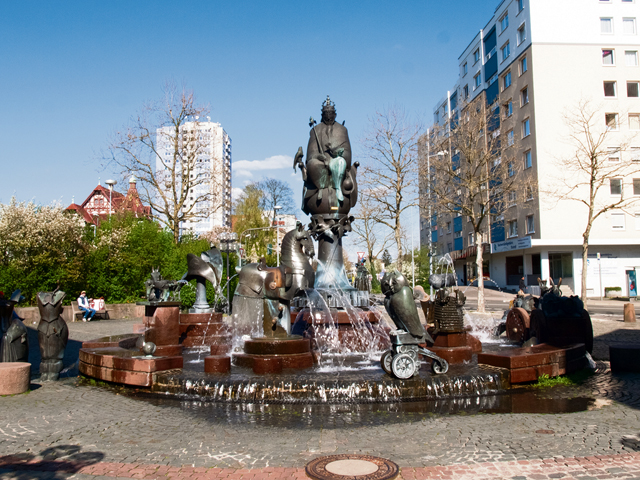
The Kaiserbrunnen (Emperor’s Fountain) at Mainzer Tor in Kaiserslautern was designed by Gernot Rumpf, a sculptor of Kaiserslautern, in 1987. The bronze fountain pictures the most important historical and current characteristics of the City of Kaiserslautern.
The most prominent feature is a sculpture of Emperor Friedrich Barbarossa (1122-1190) situated in the middle of the fountain. In 1152, Emperor Barbarossa had an imperial palace (Kaiserpfalz) commissioned in the settlement which over time has turned into what is now the City of Kaiserslautern. Emperor Barbarossa used the palace as a residence when preparing for crusades and enjoying his favorite pastime hunting.
The second person featured on the fountain is King Rudolf of Habsburg (1218-1291) who gave Kaiserslautern its city rights in 1276. Gaining these city rights meant certain privileges, for example more independence in the governing of a city or holding a market.
As the heraldic animal for the City of Kaiserslautern, a fish can be found as well. Another creature that is sculpted is the “Elwedritsche,” a regional fabulous creature, which can only be caught with a giant net on a full moon night. The owl stands for wisdom and Kaiserslautern’s history as a city of school and university, the elephants and the city towers symbolize strength of the former city walls.
An Opel engine and a Pfaff sewing machine represent the city’s economic development after World War II, while the wheels stand for the Technical University of Kaiserslautern and technical innovation.
You might have noticed that Kaiserslautern is famous for soccer. A soccer ball signed by legendary Fritz Walter is therefore part of the fountain as well. Fritz Walter from Alsenborn played for the local soccer team 1. FC Kaiserslautern for decades and led the German national team to its victory during the Soccer World Championship in 1954.
Other objects to be found are Napoleon’s hat for the time that Kaiserslautern was governed by France after the Napoleonic Wars, a horse armor of the knights of the Rittersberg as well as a donkey and a horse.
A basket with honey marks traditional beekeepers and a wagon with grapes characterizes a former viticulture area near Kaiserslautern. An emigrant ship with a cloud full of dreams above its sails symbolizes the wave of Palatinate emigrants who sailed to the United States with hopes of a prosperous future. An estimated 100,000 Palatines left the area and settled mainly in Pennsylvania in the 18th and 19th centuries.
Elegant photos can be taken as a lady or a knight behind the two sculptures on the side of the fountain.
Last but not least, a mouse is hidden among the other figures, it doesn’t hold any historical significance, but is the sculptor’s “signature” or personal identification mark. Visit the fountain, get a glimpse of history and see if you can catch the mouse!
In addition, Gernot Rumpf created further bronze fountains, such as the Glockenbaum fountain in Mainz, the Elwedritsche-Brunnen in Neustadt/Weinstrasse and the Papyrusbrunnen in Mannheim.


